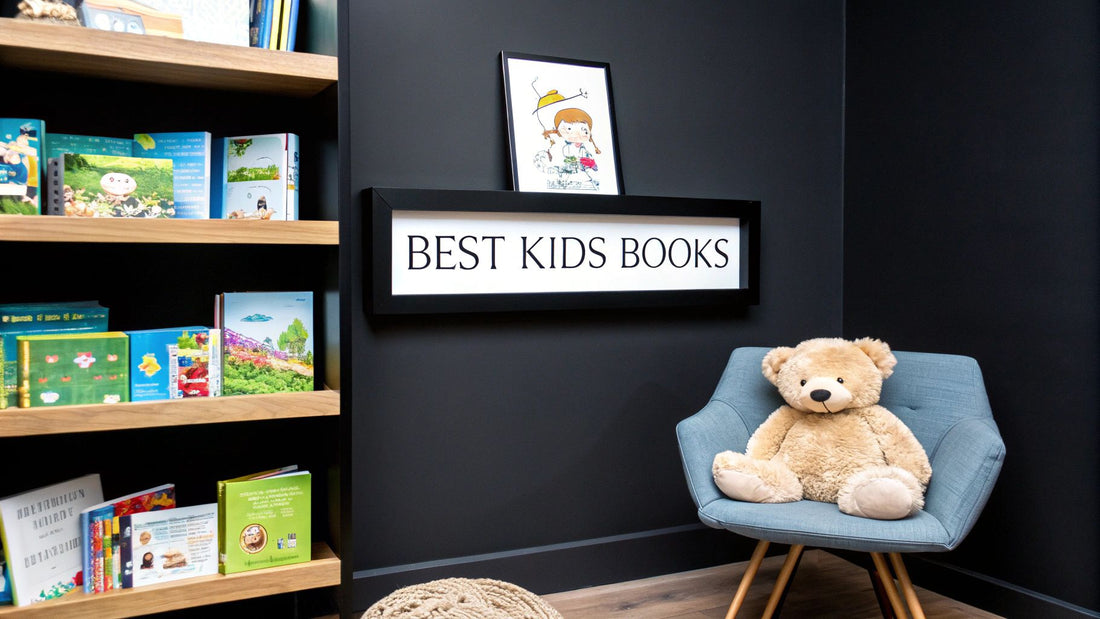
Best Books for 6 Year Olds UK Parents Love
Share
On the hunt for the best books for a 6 year old? You’ve come to the right place. At this brilliant age, timeless stories like Where the Wild Things Are by Maurice Sendak and early chapter books like Frog and Toad Are Friends by Arnold Lobel are just perfect for boosting confidence and letting their imagination run wild.
Why Reading Is So Important At Age Six
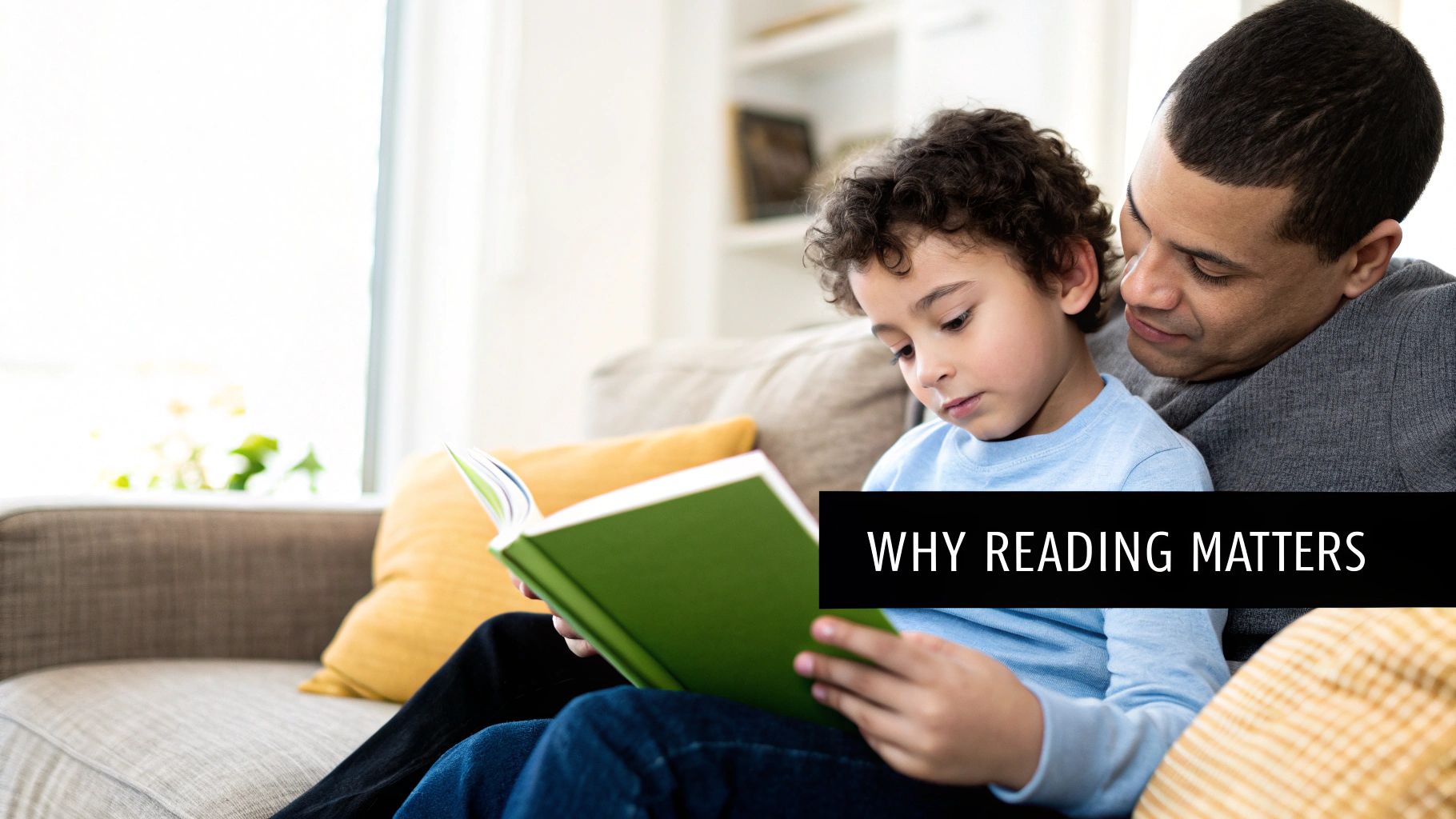
The age of six is a truly magical time in a child's reading journey. They’re making the leap from simply sounding out words to actually understanding the story and, most importantly, enjoying it. This is a massive step forward, setting the stage for a lifetime of learning and emotional development.
Think of it like learning to ride a bike. Up until now, they've been focused on the basics – how to pedal, how to balance. Now, they're finally ready to zip off and explore the entire neighbourhood. The right book is their map, showing them the way to new ideas, different worlds, and big feelings.
Building More Than Just Vocabulary
Of course, their vocabulary will explode, but the real power of reading at this age is in building their emotional intelligence. Stories create a safe space for children to explore complex feelings like friendship, loss, courage, and kindness, all through the eyes of a relatable character. The constant exposure to social media and societal pressures means that addressing mental health from a young age has never been more crucial.
This process helps them build skills they'll use for the rest of their lives:
- Empathy: When they step into a character’s shoes, they learn to see the world from a different point of view.
- Resilience: Watching characters face challenges and overcome them teaches a powerful lesson: it’s okay to struggle, and they have what it takes to find solutions, too.
- Curiosity: A brilliant story can spark a real desire to learn more about everything, from dinosaurs to distant galaxies.
Supporting Mental Well-being Through Stories
A good book does wonders for a child’s mental well-being. It’s a quiet, calming activity that can help ease stress and anxiety. For example, if a child is feeling worried about starting a new school, reading a story about a character who bravely faces the same situation can make their own fears feel more manageable and less isolating. When a child sees their own worries reflected in a story, it makes them feel less alone and more understood. To dive deeper, you can learn more about why reading books is important for people of all ages.
Books are a uniquely portable magic. They provide a vital escape and a mirror for a child's inner world, helping them process big feelings in a manageable way.
Ultimately, taking the time to find the best books for your 6-year-old is an investment in their future happiness and resilience. It's about giving them the tools not just to read the world, but to truly understand it—and their own place within it.
How To Choose a Great Book For Your Six Year Old
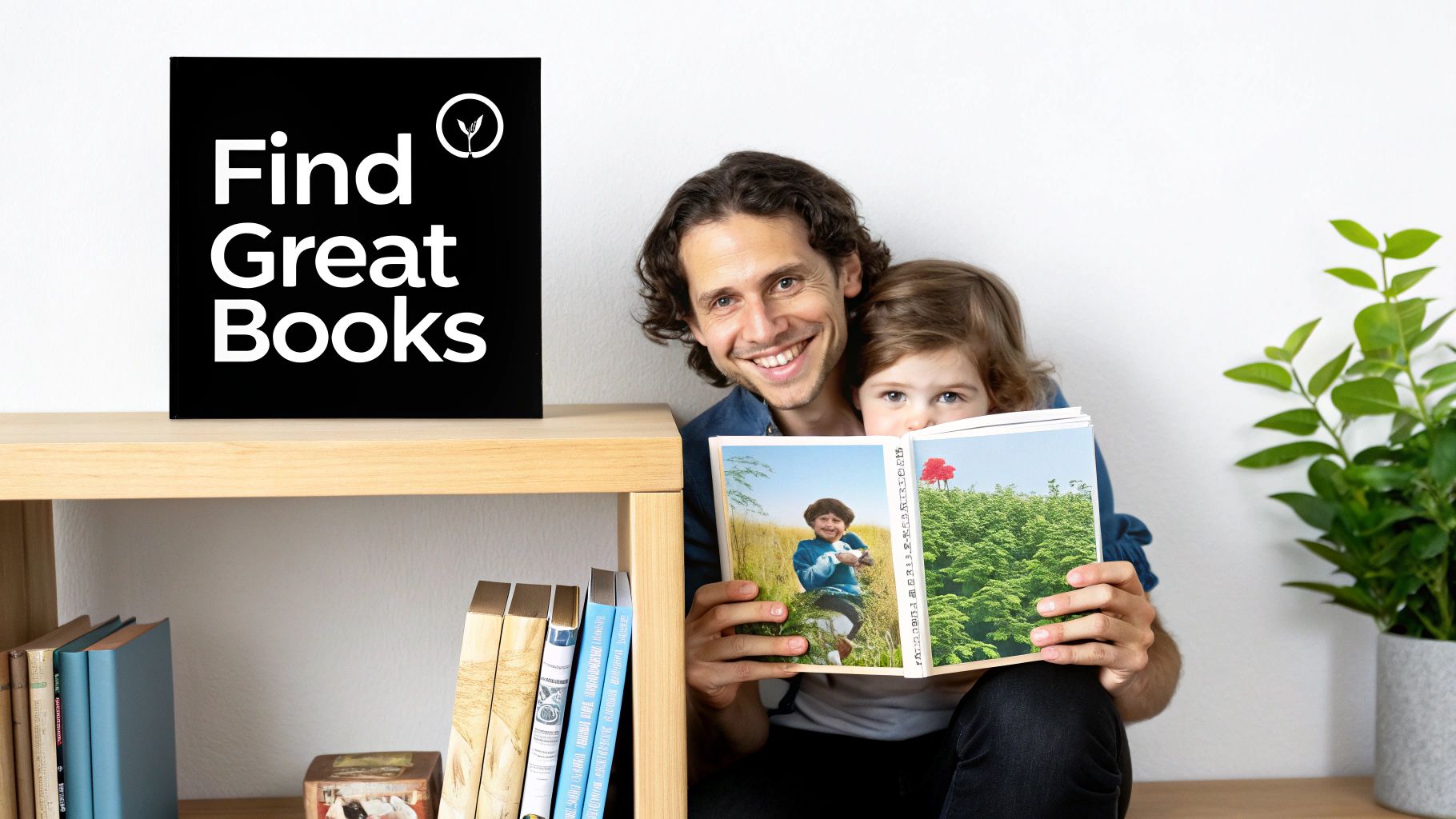
Walking into a bookshop to find the perfect book for a six-year-old can feel a bit overwhelming. The shelves are bursting with options, and it’s tough to guess which stories will genuinely capture your child's imagination. The real secret isn't about picking the book with the flashiest cover; it's about looking a little deeper at what makes a story truly special for this curious and fast-growing age.
A brilliant story for a six-year-old nearly always has a relatable main character. At this age, children are navigating their own little worlds, figuring out friendships, and facing challenges that feel huge to them. When they see a character who shares their own worries or celebrates similar triumphs, the story becomes more than just words on a page—it becomes a mirror.
This is so important for their mental wellbeing. These early years are foundational for emotional growth, and recent studies show that 1 in 6 children aged 5-16 have a probable mental health problem. The cost of neglecting this is enormous, not just for individuals but for society; poor mental health costs UK businesses up to £56 billion a year in lost productivity. Books offer a safe and gentle way to open up conversations about big feelings, building a foundation of emotional resilience from an early age.
Look For Engaging Illustrations and Clear Storylines
For a six-year-old, the pictures are just as important as the words. They aren’t just pretty decorations; they are vital storytelling tools that help children piece together the narrative, understand how a character is feeling, and stay hooked from start to finish. Look for illustrations that add an extra layer of detail and depth.
The plot itself should be simple enough for them to follow along without getting lost, but with just enough intrigue or a little problem to solve. This balance is key to keeping them engaged without causing any confusion. You can see some fantastic examples of how text and pictures work hand-in-hand in our guide to childrens picture books.
Balance Comfort Reads With New Adventures
It’s completely normal for children to ask for the same book night after night. These familiar stories are like a cosy blanket, providing comfort and predictability that feels incredibly reassuring. These comfort reads are great for building confidence and fluency, so it’s a wonderful habit to encourage.
At the same time, it's also important to gently introduce new adventures. A great way to do this is by finding books that have a similar feel to their current favourites but introduce a new theme, character, or setting. This approach helps to broaden their horizons without pushing them too far out of their comfort zone.
A child’s bookshelf should be like a balanced diet. It needs comforting favourites that nourish their confidence, alongside new and exciting stories that challenge them to grow.
To make this a little easier, here's a quick checklist to keep in mind when you're browsing the bookshelves.
Quick Guide to Picking the Perfect Book
Use this checklist to find engaging and age-appropriate books for your six-year-old.
| Feature | Why It Matters | Look For This |
|---|---|---|
| Relatable Characters | Kids connect with characters who face familiar problems like making friends or being brave. | A main character who is around their age or experiences situations they can understand. |
| Engaging Illustrations | Pictures help decode the story, show emotion, and keep their attention focused. | Colourful, detailed images that add to the story, not just decorate the page. |
| Clear Plot | A simple, easy-to-follow storyline prevents confusion and builds reading confidence. | A story with a clear beginning, a simple problem, and a satisfying ending. |
| Age-Appropriate Text | The language should be manageable, with some new words to help them learn and grow. | A mix of familiar words and a few new, exciting ones. Repetitive phrases are also great for this age. |
| Positive Messages | Stories can gently teach kindness, resilience, and empathy. | Themes of friendship, problem-solving, and being true to yourself. |
| Fun Factor! | Reading should be a joy, not a chore. | Humour, adventure, silly rhymes, or a touch of magic—anything that will make them smile. |
Ultimately, choosing a book is all about knowing your child. Pay attention to what lights them up. Is it dinosaurs, space, magic, or stories about everyday life at school? When you tap into their interests, you’re far more likely to find a book they’ll truly treasure. Your goal isn't just to find a book they can read, but one they will absolutely love to read.
Our Top Recommended Books For Six Year Olds
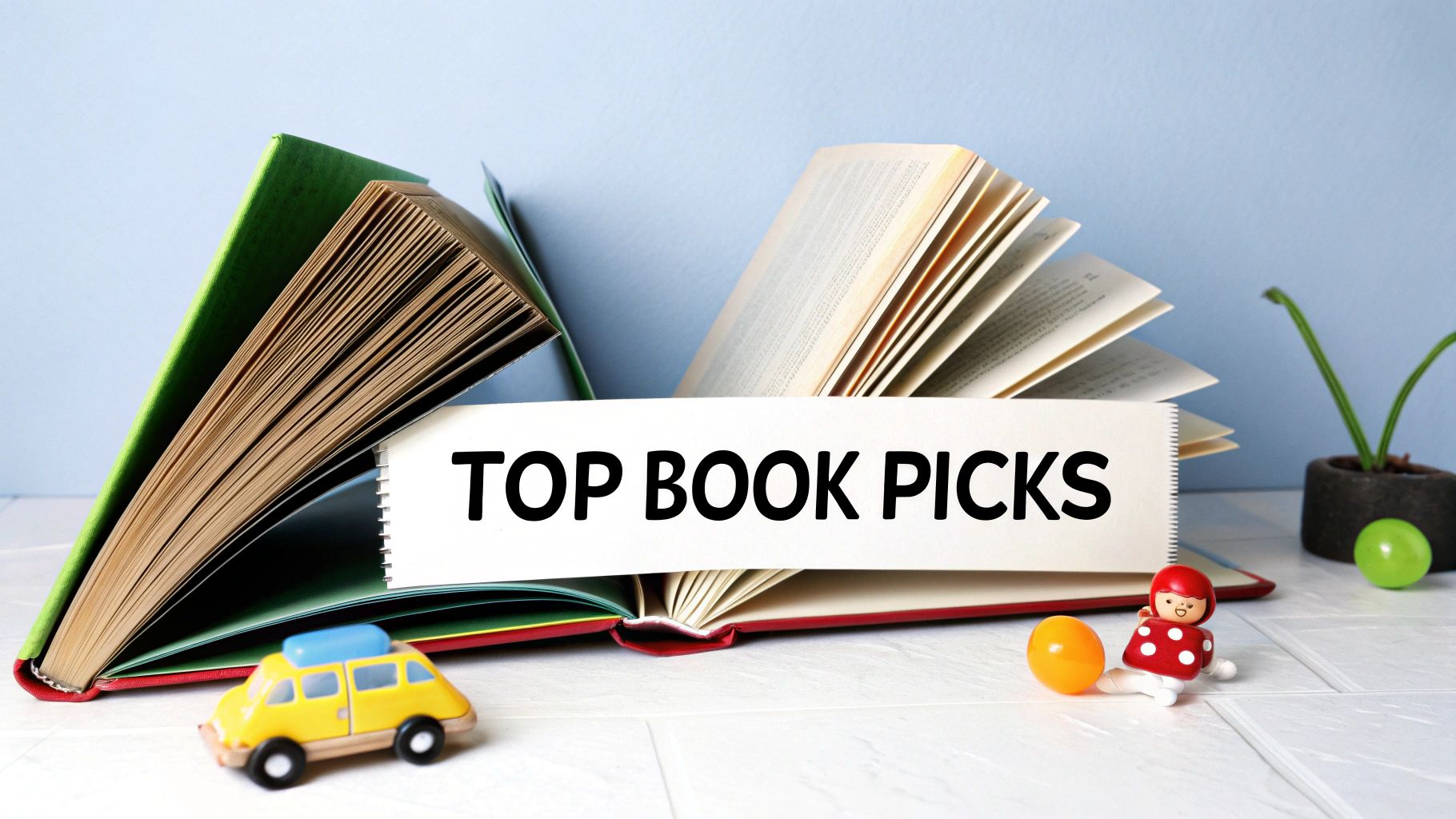
Ready to find your child's next favourite story? We’ve pulled together some of the absolute best books for six-year-old readers, sorting them into handy categories to help you find the perfect match. This list is a real mix of timeless classics and brilliant modern gems, all guaranteed to spark imagination, entertain, and build that all-important reading confidence.
The UK children's book market is wonderfully vibrant, with big names like Penguin Random House and HarperCollins consistently releasing top-quality, engaging stories. This means we parents have a fantastic and varied selection to choose from, even when belts are tight. The enduring popularity of sturdy hardback books also shows a real love for physical copies that can be read and treasured over and over again.
Laugh-Out-Loud Adventures
Humour is one of the best ways to get a six-year-old completely hooked on reading. Funny stories create a really positive feeling about books, and they’re often packed with the wonderfully silly characters and absurd situations that children find hilarious.
- Oi Frog! by Kes Gray and Jim Field: This book is pure rhyming genius. Frog doesn't fancy sitting on a log, but Cat has a non-negotiable rule for where every single animal must sit. The clever wordplay and brilliant illustrations make it an absolute joy to read aloud, and it’s a fantastic way to introduce rhyming patterns.
- Don't Let the Pigeon Drive the Bus! by Mo Willems: A modern classic where your child is put right in the driver's seat (so to speak). The Pigeon’s increasingly desperate and hilarious pleas to drive the bus will have your little one shouting "No!" and giggling uncontrollably. It’s simple, interactive, and just so clever.
When it comes to presents, especially around the holidays, books are a perfect choice for something both fun and meaningful. If you're hunting for more ideas along those lines, you might find this guide on Christmas Gifts For Kids That Aren't Toys really helpful.
First Chapter Books To Build Confidence
Moving onto chapter books is a huge milestone for any young reader. The secret is finding titles with short chapters, plenty of illustrations for support, and plots so engaging that the transition feels exciting rather than intimidating.
"A great first chapter book gives a child that amazing feeling of 'I did it!' It builds the stamina and self-assurance they need to tackle longer, more complex stories down the road."
Here are a couple of excellent starting points:
- The Worst Witch by Jill Murphy: Mildred Hubble is a clumsy but kind-hearted student at Miss Cackle's Academy for Witches. These stories are full of gentle humour, magical mishaps, and relatable friendships, making them perfect for newly independent readers finding their feet.
- Frog and Toad Are Friends by Arnold Lobel: This is a collection of five short, sweet stories celebrating the heartwarming friendship between a cheerful frog and a slightly more serious toad. The simple language and charming tales of their everyday adventures make it one of the best books for six-year-olds building up their reading confidence.
Stories That Teach Kindness
Books are a beautiful way to explore some of life's most important lessons. Stories that centre on empathy, kindness, and understanding others can help children navigate their own friendships and social situations with a bit more compassion. These tales offer gentle guidance without ever feeling like a lecture.
- The Lion Inside by Rachel Bright and Jim Field: A tiny mouse wishes he had a roar like a lion so he would stop being overlooked. This gorgeous story teaches children that we all have a bit of lion and a bit of mouse inside us, and that real courage comes from speaking up, no matter how small you feel.
- The Boy, the Mole, the Fox and the Horse by Charlie Mackesy: While many adults love this book, its simple, profound messages about kindness, hope, and friendship connect deeply with children, too. It's a perfect book to read together, with stunning illustrations that naturally open up conversations about big feelings.
Exploring Reading Formats Beyond The Page
While there’s an undeniable magic to a traditional picture or chapter book, the world of stories for a six-year-old is now so much wider. Exploring different reading formats isn’t just about adding variety; it’s a brilliant way to tap into your child’s unique learning style, keep them hooked on stories, and build different but equally important skills.
Think of it as creating a balanced 'reading diet'. Just as a mix of foods nourishes a growing body, a mix of reading formats nourishes a developing mind. This approach helps ensure reading always feels like a treat rather than a chore, which can make all the difference for a child who’s a bit reluctant to pick up a standard book.
This varied approach is definitely catching on. In the UK, while print books are still going strong, audiobook revenue has more than doubled since 2019, now worth over £200 million. This isn't just a number; it shows a real shift in how families are enjoying stories together. For our six-year-olds, this means they have access to an amazing mix of media, making brilliant stories available to everyone, no matter their reading fluency. You can discover more insights about the UK book market on Statista.com.
The Power Of Audiobooks
Audiobooks are a fantastic tool for this age group, and they're far from a 'shortcut' to reading. In fact, they’re a powerful way to build crucial listening comprehension and vocabulary. When a child hears a story read by a skilled narrator, they’re exposed to expressive language, natural pacing, and rich new words they might not be able to read on their own yet.
This auditory experience is especially brilliant for:
- Building Vocabulary: Kids hear words used in context, which helps them grasp meaning and proper pronunciation.
- Improving Listening Skills: It trains them to focus, follow a plot, and hold onto information – all vital skills for the classroom.
- Supporting Reluctant Readers: For a child who finds the physical act of reading tiring, an audiobook offers a completely pressure-free way to get lost in a story.
By taking the pressure of decoding off their shoulders, audiobooks allow a child's imagination to truly run wild. They can just close their eyes and paint a picture of the world the story creates. For a deeper dive, you can learn more about how audiobooks and ebooks help children with reading in our guide.
The Visual Appeal Of Graphic Novels
And please, don't overlook graphic novels! These are so much more than just comic books. They are sophisticated storytelling tools that cleverly blend text with visual clues. For a six-year-old, this format is incredibly engaging and can be the perfect bridge to longer chapter books.
The combination of pictures and words in graphic novels helps children infer meaning, understand character emotions through expressions, and follow a plot in a dynamic way. It’s a complete narrative experience.
Graphic novels are particularly great for visual learners. They help kids develop an understanding of story structure, sequence, and character development in a way that feels completely natural and fun.
By offering a mix of these formats, you give your child multiple paths to fall in love with storytelling for life.
Simple Ways To Nurture a Lifelong Love Of Reading
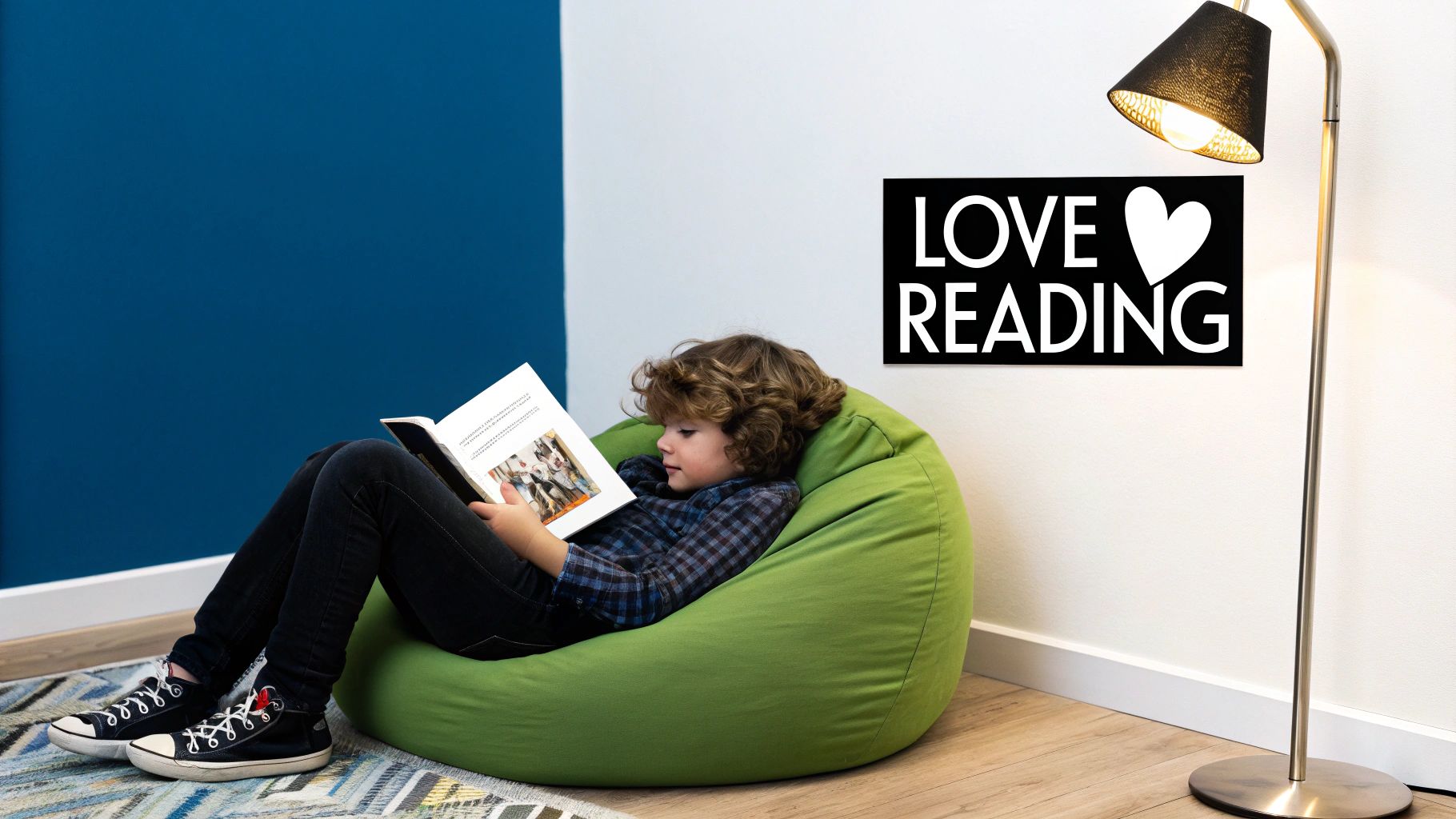
Having a shelf stacked with brilliant books is a fantastic start, but the real magic happens when reading becomes a joyful part of your family's daily rhythm. It’s all about creating a culture at home where stories are celebrated, not just assigned. This small shift can transform reading from a task into a cherished activity that supports their emotional well-being for years.
The goal is to make books feel like a treat, not a chore. This positive association is incredibly important, especially as children start navigating the complex social worlds of school and friendships. A great story offers a moment of calm and connection in a busy day, giving them a vital tool for relaxation. For instance, try a simple breathing exercise: read a short, calming sentence from a book and have your child take a slow, deep breath in, then breathe out as you finish the sentence.
Thankfully, we have an incredible selection of stories right at our fingertips. The UK holds a significant 16% share of the European children's book market, a sector projected to be worth around $3 billion. This deep cultural commitment means we have access to a rich and ever-growing library of high-quality, inclusive books designed to help young readers understand themselves and the world around them. You can read the full research about the children's book market here.
Create a Cosy Reading Nook
You don't need a dedicated library to spark a love of reading. A simple, inviting space can make all the difference. Think about carving out a small, comfortable corner that is purely for curling up with a book.
This special spot sends a clear message: reading is a valued and enjoyable thing to do in our home. All it takes is a few simple touches:
- Comfort is Key: Think soft cushions, a fluffy rug, or even a comfy beanbag.
- Good Lighting: Make sure there’s a gentle lamp or plenty of natural light to avoid eye strain.
- Easy Access: Keep a small basket of their favourite books nearby so they are always within easy reach.
This little sanctuary gives your child a go-to place for quiet time, helping them associate reading with peace and comfort. It gives them a wonderful sense of ownership over their reading journey.
Make Reading an Interactive Experience
To truly nurture that lifelong passion, you have to move beyond just reading the words on the page. Turn story time into an interactive adventure that engages their creativity and critical thinking. This shared experience strengthens your bond and helps them connect more deeply with the story.
By making reading a shared, active pursuit, you show your child that stories are not just something to be consumed, but something to be explored, questioned, and brought to life together.
Try weaving some of these simple, fun ideas into your routine:
- Ask Open-Ended Questions: Instead of "Did you like it?", try asking, "What do you think will happen next?" or "How do you think that character felt when that happened?"
- Act It Out: Use silly voices for different characters or act out your favourite scenes. It’s a brilliant way to explore emotions and what makes the characters tick.
- Get Creative: Encourage them to draw a picture of their favourite part or even come up with a different ending for the story.
One of the most powerful ways to foster this love is by making reading part of their daily routine, especially at bedtime. A calming story is a wonderful way to wind down. For more ideas on this, you might find some useful strategies for helping children fall asleep. These simple habits build a powerful foundation, turning reading into a treasured habit that lasts a lifetime.
Common Reading Questions from Parents
It’s completely normal to have a million questions pop up as you guide your child through their reading journey. Honestly, we all do. From navigating a sudden refusal to read to figuring out their funny little habits, let's tackle some of the most common concerns we hear from parents.
One big, often unspoken, worry is how a child's mental health plays into all of this. A child's overall wellbeing can have a huge impact on their interest in things like reading. It’s so important to be mindful of this, as struggles with mental health in childhood can cast a long shadow if they aren't addressed with care.
What Should I Do if My Child Doesn't Want to Read?
First off, take a deep breath. Don't let it become a battle of wills. A child’s reluctance to read is usually just a phase and can be down to anything from being overtired to feeling like the books are a bit too tricky. The best thing you can do is make reading a low-pressure, cosy activity again. Simple things, like creating a comfy reading nook or just reading a story aloud to them, can make all the difference.
It's important to state that I am not a mental health professional. If you have genuine worries about your child's mood, anxiety, or a persistent lack of interest in things they used to love, it is always best to speak with your GP or a qualified professional for advice.
Remember, reading should be about joy and connection, not stress. If a child is struggling, focusing on making it fun will build a much stronger foundation than forcing them to get through another chapter.
Is It Okay If They Read the Same Book Over and Over?
Yes, absolutely! In fact, it's a brilliant sign. When a child re-reads a favourite book, they're building incredible confidence and fluency. They are mastering that story, which feels powerful and deeply comforting. It’s a bit like us re-watching a favourite film; there's a lovely security in knowing exactly what’s going to happen.
If you want to gently nudge them towards something new, you could try suggesting other books by the same author or stories that touch on similar themes. There are also some wonderful mental health books for children that explore feelings in a gentle, accessible way, helping them build emotional literacy while they enjoy a new adventure.
Sometimes, just starting a conversation can be the hardest part. Something as simple as wearing mental health apparel with a positive message can open up discussions about feelings for the whole family. It helps normalise these chats, showing everyone that it’s okay to talk about our emotions. Fostering that open environment is one of the most powerful things you can do for their wellbeing.
At Little Fish Books, we believe in nurturing emotional literacy from a young age. Our curated collection of books and resources is designed to help children understand their feelings and build resilience. Explore our range and discover tools to support your child's emotional growth at https://thatsokay.co.uk.
